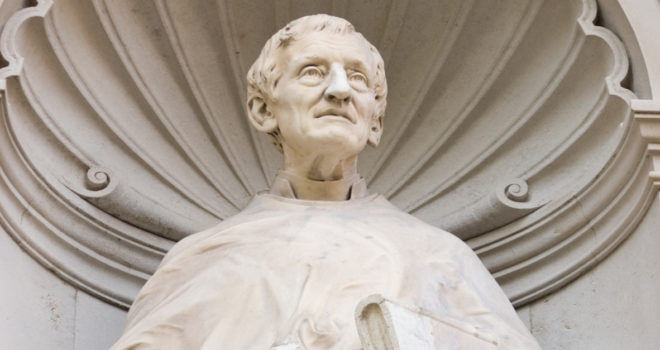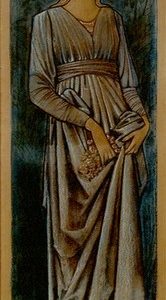A true genius must be defined by great ideas that
are at once clear, simple, and uniquely brilliant.
St. John Henry Newman, who was canonized on Sunday, surely qualifies as a genius under this definition. Newman was canonized because of his personal holiness, not his intellect, but the former surely engendered the latter. Charity and truth, after all, are inextricably linked. That’s because God is love and truth (1 John 4:8; John 14:6).
Newman’s poems, sermons, letters, and other works
all glitter with his genius, but two of his works—and the titanic ideas
associated with each one—seem to stand above the rest. One was written right
before Newman entered the Church. The other came late in life. Together they
stand as sort of bookends on a spectacular literary career.
The Paradox of Doctrine
The first work is An Essay on the
Development of Christian Doctrine,
published in 1845, in which Newman set out to resolve an apparent paradox—the
fact that Christian belief and practice has undeniably varied over the
centuries and yet remains ‘unchanging.’
One example of this is Marian doctrine and devotion:
no one in the first century was carrying a rosary or referring to Mary as the
Immaculate Conception or the Mediatrix of All Graces. And yet there is one true
deposit of faith that has been handed down through the ages.
How do we reconcile these two truths?
Newman’s ingenious solution was to recognize that
doctrine ‘develops.’ According to Newman, everything the Church believes and
practices today was present in ‘seed form’ from the earliest times. Just as the
seed grows into a sapling, then a young tree, and finally into a mature tree,
so also doctrine develops. In this way the truth of the faith remains always
the same, yet is ever new.
So, to take the example of Mary, the Doctrine of the
Immaculate Conception has deep roots in Scripture. In fact, it goes all the way
back to Genesis. Catholics today understand Mary as the New Eve, just as Jesus
was the New Adam. Given that Eve was born without the stain of original sin,
then Mary must have been born free from the burdens of original sin. Her
lifelong sinlessness can also be argued from the basis of her identity as the
new Ark of the Covenant, which, like Mary, was spotless and without corruption.
Skipping ahead to the early Church, we can see
evidence that the first Christians recognized there was something special about
Mary from the beginning. In the 200s, Hippolytus used language that anticipates
the Immaculate Conception, describing Mary as “the ark formed of incorruptible
wood. For by this is signified that His tabernacle was exempt from putridity
and corruption” (Orations In illud,
Dominus pascit me). In the late 300s, St. Athanasius—who is remembered as a
bastion of Nicene orthodoxy in a time of Arian domination—uttered these
extraordinary words in a homily:
O noble Virgin, truly you are greater than any other greatness. For who is your equal in greatness, O dwelling place of God the Word? To whom among all creatures shall I compare you, O Virgin? You are greater than them all O Covenant, clothed with purity instead of gold! You are the Ark in which is found the golden vessel containing the true manna, that is, the flesh in which divinity resides.
The doctrine of the Immaculate Conception was always
there. It just took a while for the contours of the doctrine to flesh out. Just
as we say that a person is a person regardless of whether we’re talking about a
fertilized egg or a fully grown person, so also we can say that Church doctrine
is always the same and yet it ‘changes’ in a way—it develops. This was Newman’s
great insight.
Beyond his contributions to Church doctrine,
Newman’s Essay, deserves acclamation
for two other reasons. First, it also doubles as a work on intellectual
history, with Newman’s extensive discussion of the nature of ideas and their
relationship with history. Second, Newman’s poetic descriptions of the nature
of the Christian faith are among the most beautiful ever written. Consider this
description of the vastness of Scripture:
It is in point to notice also the structure and style of Scripture, a structure so unsystematic and various, and a style so figurative and indirect, that no one would presume at first sight to say what is in it and what is not. It cannot, as it were, be mapped, or its contents catalogued; but after all our diligence, to the end of our lives and to the end of the Church, it must be an unexplored and unsubdued land, with heights and valleys, forests and streams, on the right and left of our path and close about us, full of concealed wonders and choice treasures (Part 1, Chapter 2, Section 1.14).
Or this observation on the nature of Christianity
itself,
I should myself call the Incarnation the central aspect of Christianity, out of which the three main aspects of its teaching take their rise, the sacramental, the hierarchical, and the ascetic. But one aspect of Revelation must not be allowed to exclude or to obscure another; and Christianity is dogmatical, devotional, practical all at once; it is esoteric and exoteric; it is indulgent and strict; it is light and dark; it is love, and it is fear (Part 1, Chapter 1, Section 1.3).
How to Be Certain in Your Faith
Newman’s other work of singular genius came decades
later in 1870. An Essay in Aid
of a Grammar of Assent explored how we
achieve certitude in our faith. At times, the work can seem more like a logic
textbook, but it’s worth wading through it—eventually Newman’s wit and insight
shine through.
The central insight of this A Grammar of Assent is the embrace of two seeming contraries—that
faith is not a matter of mathematical certitude and yet that true certitude is
not only possible but also essential in matters of Christian belief.
Newman recognizes that we don’t arrive at the truth of Christian faith in the same way that we solve an equation or work out a problem of logic from premises to the conclusion. Here, it may seem like he concedes the argument to shallow atheist critics. But one of Newman’s insights is that certitude in belief should not be a cold rationalistic process. As one writer, summarizing Newman’s thought, put it,
It means nothing to us personally whether if A is larger than B and B larger than C, that A is larger than C, or that if all men are mortal and Socrates is a man, that Socrates is mortal, as these are merely an exercise in the classroom. But it does matter to us surely if we believe that since the Bible is the inspired Word of God, and we believe that all things in it are substantially true, that therefore it is true that the Lord God gave Moses the Ten Commandments on the holy mountain or that Jesus came down to earth to die for our sins. Thus Newman distinguishes between the manner in which we apprehend the living truths of religion and merely accede to an inference in the manner of analyzing syllogisms, between real and notional assent.
So we cannot be certain about faith in the same way
that we are certain that 2+2=4. And yet, Newman says we can still be certain
about faith. How is this possible? Newman argues that we can arrive at certitude
in belief through a process of inference, instead of deductive reasoning. For
example, from the existence of a moral conscience we can infer the existence of
God.
Over the course of the book, Newman’s passion for
finding and defending the truth shine forth. And this was no mere intellectual
exercise. Newman understand that the head was inextricably linked to the heart.
To those who might accuse of spending too much time in the intellectual weeds,
Newman countered that in order to love God we must first know God:
We love our parents, as our parents, when we know them to be our parents; we must know concerning God, before we can feel love, fear, hope, or trust towards Him. Devotion must have its objects; those objects, as being supernatural, when not represented to our senses by material symbols, must be set before the mind in propositions. The formula, which embodies a dogma for the theologian, readily suggests an object for the worshipper. It seems a truism to say, yet it is all that I have been saying, that in religion the imagination and affections should always be under the control of reason. Theology may stand as a substantive science, though it be without the life of religion; but religion cannot maintain its ground at all without theology. Sentiment, whether imaginative or emotional, falls back upon the intellect for its stay, when sense cannot be called into exercise; and it is in this way that devotion falls back upon dogma (Part 1, Chapter 5, Section 1).
Today, in our age of unbelief, Newman addresses us,
not only on an intellectual level, but on the level of the heart, hence his
episcopal motto—Cor ad Cor loquitur.
And, thanks to his canonization, we can now rely his intercession to help us
become more certain in our faith and more confident in its doctrines that we
might grow in in love of God and His Church.












